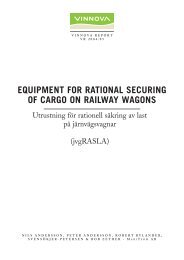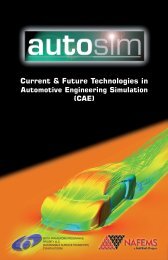WP3: Rail Passenger Transport - TOSCA Project
WP3: Rail Passenger Transport - TOSCA Project
WP3: Rail Passenger Transport - TOSCA Project
You also want an ePaper? Increase the reach of your titles
YUMPU automatically turns print PDFs into web optimized ePapers that Google loves.
Combination of measures<br />
The combination of all measures produces very significant reductions in energy use. Even if<br />
we exclude ‘Low-GHG electric power’, the estimations and simulations end up with a<br />
reduction of energy use and GHG by about 56 % on average, with the largest reduction for<br />
stopping ‘Local city trains’ at 60 %. This is a result of both less intake of energy and increased<br />
energy recovery, so that the resulting net energy is heavily reduced. Note that train speeds are<br />
assumed to be constant at this first stage of estimation.<br />
Estimated overall energy use and GHG reduction,<br />
excluding effect of higher speed and ‘Low-GHG electric power’: 56 %<br />
impact on operation cost, excluding energy: –10 %<br />
end user average willingness to pay: –3 %<br />
Higher speeds and combinations<br />
With all other conditions being equal higher speeds will increase energy consumption and the<br />
resulting GHG emissions. These negative effects are however expected to be essentially<br />
compensated by adapting technologies to increased speed. Shorter travel time will reduce<br />
operating cost due to higher productivity of trains and train crew. Most important, shorter<br />
travel time will increase willingness to pay. In all, trains will be more competitive. Also, from<br />
a socio-economic perspective shortened travel time will in many cases have benefits.<br />
The major drawback is the need for a high-performing rail infrastructure, which in certain<br />
cases would trigger a negative public opinion and usually require public funding. It should<br />
however be noted that higher speed and improved infrastructure does not only apply to veryhigh-speed<br />
rail (top speed 250 km/h and above), but also upgrading of conventional railways<br />
for top speeds lower than 250 km/h.<br />
Estimated overall GHG reduction, excluding effect of ‘Low-GHG electricity’ 46 %.<br />
impact on operation cost, excluding energy: –11 %<br />
end user average willingness to pay: +12 %<br />
Incentives needed<br />
The used interest rate for increased vehicle investment is chosen from a long-term perspective<br />
and is not including profit margins in profit-making operating companies. This fact indicates<br />
that further incentives – subsidies or penalties – in addition to energy cost savings, may be<br />
required for some technologies, in particular for ‘low-drag’ and ‘low-mass’.<br />
6.2 Conclusions<br />
In the present analysis it is estimated that a number of efficient technologies, individually and<br />
in combination, are available in order to significantly reduce energy use and the resulting GHG<br />
emissions on the rail passenger market until 2050.<br />
The analysis has considered different technologies and means<br />
– reduced air drag<br />
– reduced train mass<br />
– energy recovery<br />
– eco-driving, including traffic flow management<br />
– space efficiency in trains<br />
– incremental improvements in energy efficiency, in particular reduced losses.<br />
Deliverable D4 – <strong>WP3</strong> passenger 37
















